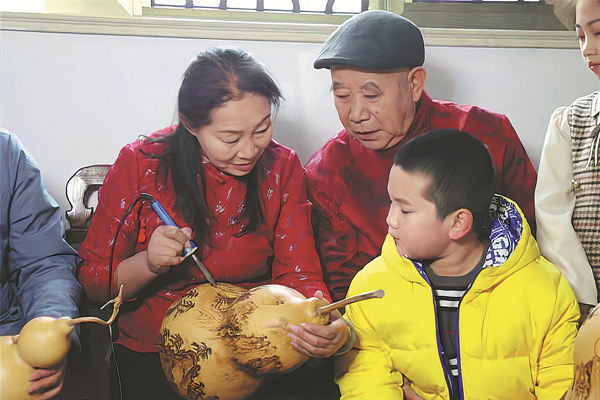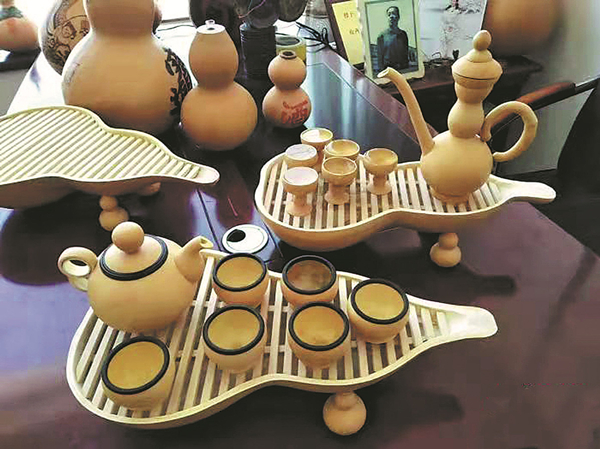Pyrography lights fire in hearts of villagers

Xue Gailian (left) creates pyrographic art on a gourd in her studio in Wucun village, Wenshui county, Shanxi province. [Photo/China Daily]
National inheritor of gourd art heritage helps improve lives, boost incomes in Shanxi province by sharing skills
Over the past 20 years, 65-year-old Xue Gailian has used pyrography - a form of intangible cultural heritage in Shanxi province - to decorate gourds and help fellow villagers make money.
Two decades ago, Xue, like most residents of Wucun village in Shanxi's Wenshui county, made a living by growing grapes.
However, her income was heavily dependent on the climate and soil conditions.
"In 1996, I began to plant gourds in my yard, and harvested 27 that year," Xue said. "There is a long history of traditional gourd crafting in my hometown, so I tried to paint on them."
Xue, who has loved painting since she was a child, started with auspicious Chinese symbols, such as dragons, phoenixes and lotus flowers.
"I displayed some of the more satisfying pieces at home," she said. "To my surprise, when friends visited, they seemed to be really interested in them and showered me with praise."
Xue began to plant more gourds, reaping a good harvest almost every year.
Meanwhile, she began to experiment with pyrography - the art of burning images into wood or other materials using heated tools like a poker or a soldering iron.
She developed an interest in the art, which has been practiced since ancient times in her hometown, after learning more about its history.
"At first, it wasn't very easy for me to master the tools, and I wasn't able to make good images," she said. "To improve, I traveled to Shandong province and Tianjin to learn from skilled folk artists."
After she mastered the art form, Xue decided to use her skills to benefit her hometown.

A collection of gourd souvenirs made by Wucun villagers [Photo/China Daily]
In 2002, she and her husband started a gourd planting and processing center in their village, helping fellow villagers increase their incomes.
"I'm going to plant 3.5 hectares of gourds this year, and in total, about 133 hectares of village farmland are going to be used to grow gourds," she said.
"About a third of what we harvest now is used locally, and the rest is sold to other regions."
Xue also set up a gourd pyrography association and has taught more than 100 residents how to create pyrographic art for free.
Around 2010, as the popularity of gourd pyrography began to grow and gain the support of the Wenshui government, other products created by the villagers, such as water containers and musical instruments, began to draw attention at domestic exhibitions.
Gradually, their products piqued interest in overseas markets, including those in Japan and Singapore.
In 2013, a cooperative focused on the village's distinctive gourd industry was founded, and over 100 families joined.
"The cooperative provides members planting equipment, methods for field management and purchase and sales outlets. Now, we have developed more than 100 varieties of gourd products," Xue said.
"There are around 300 households in the village, and over 90 percent of the villagers are involved in growing gourds. Compared to other crops like corn, they have increased sales revenues from 15,000 yuan ($2,354) per hectare to 255,000 yuan per hectare."
Xue said that more young people have returned to the village, including her two daughters, 40-year-old Liu Lihua and 36-year-old Liu Wenli.
Both quit jobs in private enterprises in more developed cities and returned home to learn pyrography from their mother.
In 2020, Lihua and Wenli became city-level inheritors of the intangible cultural heritage.
"Young people have found brighter prospects in the gourd industry and are willing to work hard to reap a good harvest," Xue said.
Last year, Wucun gourd pyrography was listed as a form of national intangible cultural heritage, and Xue was named a national inheritor.
"In the future, I will introduce more scientific methods to improve the cultivation of gourds," she said. "I will also do more research into gourd pyrography and teach people to develop more products that better represent our region's styles and cultures.
"I hope to create a complete gourd industry chain, and show more people the charm of traditional Chinese folk arts and crafts."
Peng Ke'er contributed to this story.



